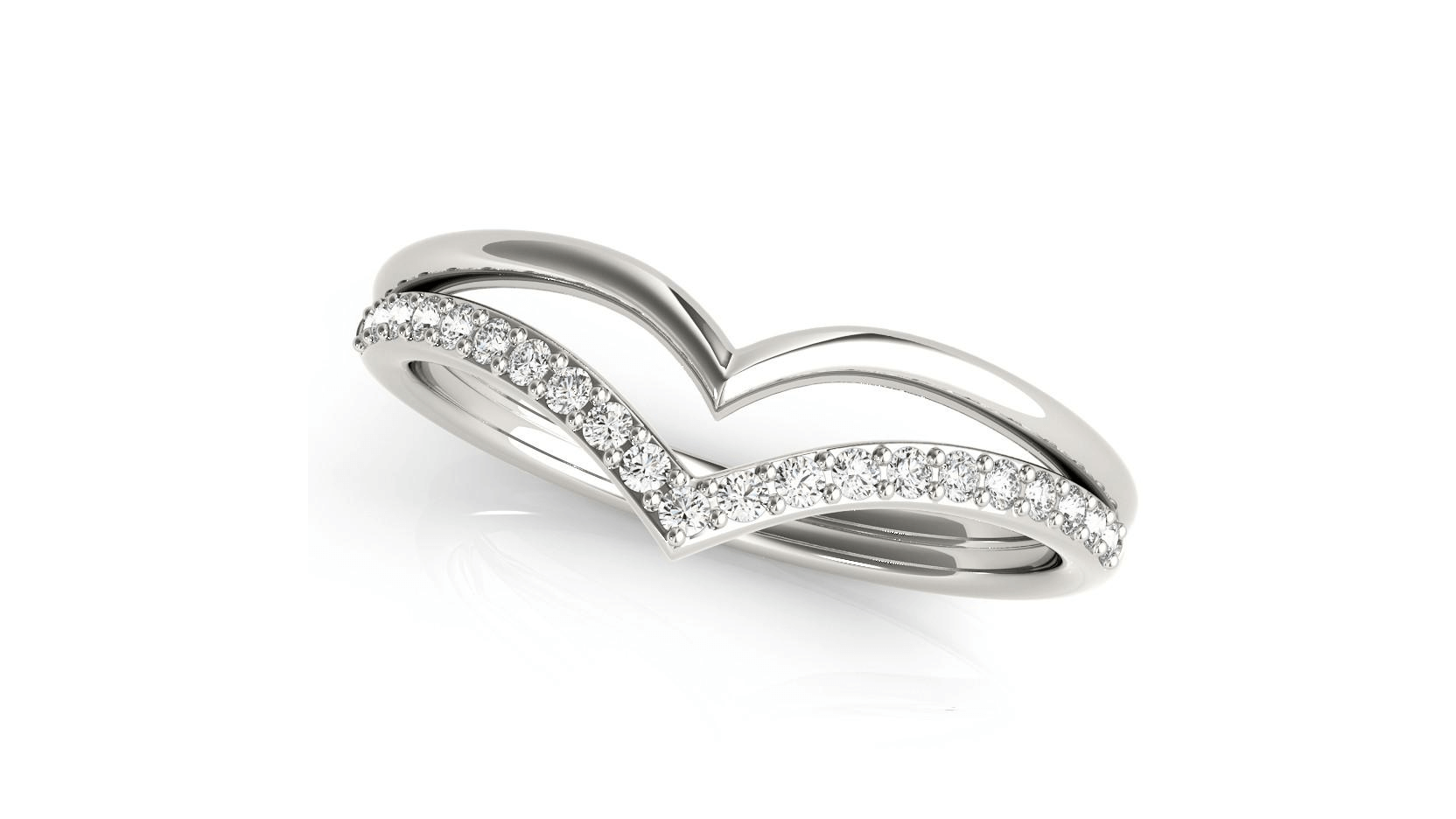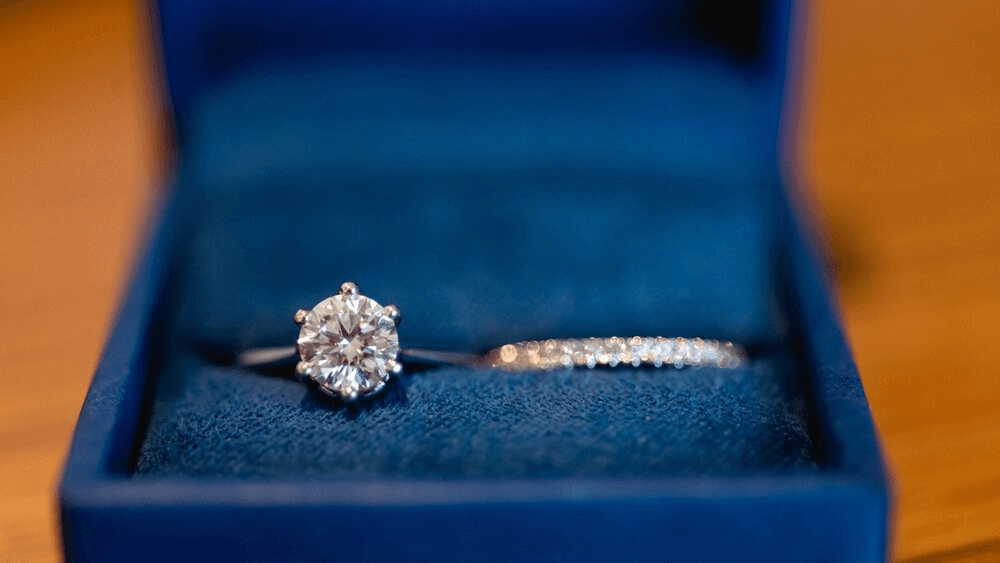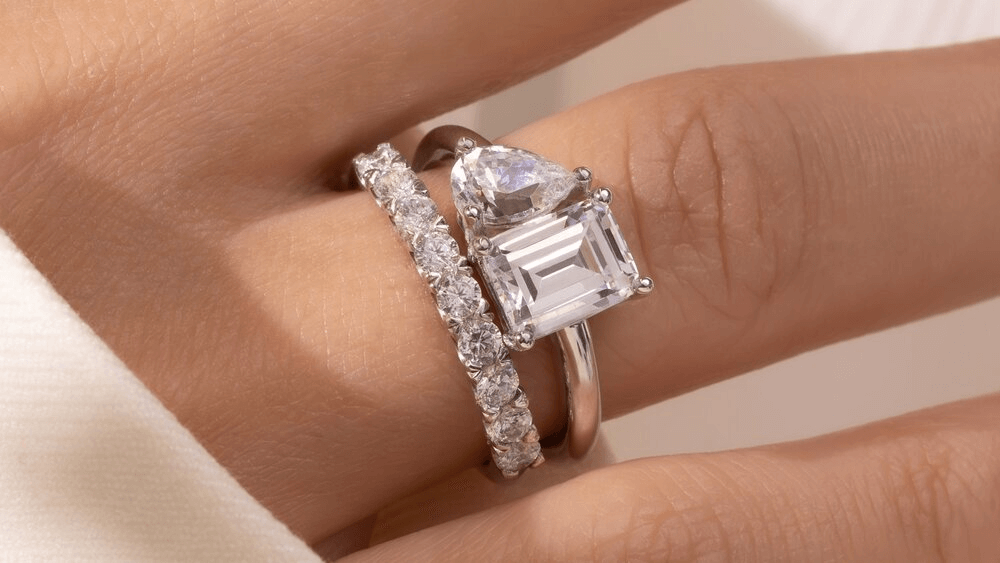Wedding Ring Budgeting: How Much Should You Really Spend?

By Gary A.

Edited by Olivia H.
Published Aug 17, 2021
Edited on Dec 18, 2024
Balancing style and budget, the average wedding ring cost varies, but understanding key factors like metal choice and design can help you find the perfect ring without overspending.

Navigate This Guide:
- 8 Quick Tips for Evaluating the Cost of Wedding Bands
- Introduction
- Market Insights: What’s the Average Price?
- Setting a Realistic Budget
- Gold, Platinum, Diamonds: A Cost Comparison
- Our Expert Take
- 10 FAQs
Before we dive deeper into the specifics, here are some practical tips to help guide your decision-making process:
8 Quick Tips for Evaluating the Cost of Wedding Bands
When shopping for wedding bands, it’s important to consider various factors that impact their cost. This guide focuses on practical tips to help you make an informed decision, especially when examining the “average wedding ring cost” and understanding “how much should a wedding ring cost.”
- Tip 1: Choose the Right Metal: Gold is a classic choice with options like yellow, white, and rose gold. 14K gold offers durability and affordability compared to 18K. Alternative Metals: Consider metals like titanium, tungsten, or stainless steel for more budget-friendly options that are still durable and stylish.
- Tip 2: Consider Band Width and Thickness: Thicker and wider bands typically use more material and therefore cost more. Determine the ideal width and thickness that balances aesthetics and budget.
- Tip 3: Understand the Impact of Design and Embellishments: A simple band will generally be less expensive than one with intricate designs or additional stones.
- Tip 4: Customization Costs: Custom designs or engravings can add to the cost. Decide if these personal touches are worth the extra expense.
- Tip 5: Evaluate Gemstone Inclusions Gemstones: If you prefer a band with diamonds or other gemstones, remember this will increase the price. Smaller stones or alternative gems can be budget-friendly choices.
- Tip 6: Gemstone Quality: Like diamonds, other gemstones have quality grades. Opt for lower-grade gems to reduce costs without significantly affecting the look.
- Tip 7: Consider Long-Term Maintenance: Some metals require more upkeep than others. A more durable metal might have a higher upfront cost but could save money on maintenance in the long run. Resizing and Repairs: Factor in the potential cost of resizing and repairs, especially for metals like tungsten, which are difficult to resize.
- Tip 8: Balance Style with Practicality: Think about your lifestyle and daily activities. A more practical, durable band might be a better investment than a more delicate design that fits your style but requires frequent repairs.
Now that you’ve got these practical tips, use Jeweler AI below to find the perfect engagement ring that suits your style and budget:
Introduction
While the engagement ring probably has a budget all of its own, most brides and grooms planning their wedding tend to have to find a space within the overall budget for the wedding rings. This is simply because of the fact that, while that diamond currently sitting pretty on her finger was the ‘main act’ of the proposal, the wedding day itself comprises a (still growing) list of investments, from food to music, the dress, venues, flowers and, well, you get the point.
Chances are, that list is all too familiar to you right now.
So, how much should you spend on a wedding ring? It’s pretty likely you’re scared to aim too low, since this band holds such significance for the wedding and marriage itself – but also likely that you’re scared to go over the top, and set aside a big chunk of your budget when, in reality, you don’t need to…
Market Insights: What’s the Average Price?
The average wedding ring cost in 2020 was just over £1,100 for brides, and just shy of $500 for grooms.
It’s always helpful to know what The Joneses are spending. And, while there’s no obligation to spend the national average, this number offers a handy guideline if you’re feeling kind of lost at sea.
When it comes to the wedding ring vs engagement ring debate, it’s safe to say that, for the overwhelming majority of couples, the engagement ring will represent the biggest expense by far. This is primarily because the wedding ring, while cast from precious metals, will not include any of the features that drive up the cost of an engagement ring.
We are, of course, mainly talking about the diamond, which tends to make its big appearance at the proposal, rather than the wedding ceremony.
Setting a Realistic Budget
The budget will always vary from couple to couple. Use the average wedding ring cost as a guide, along with your own budget for the wedding. The ring needs to be strong, durable, and beautiful – but it doesn’t need to break the bank.
You can either choose to buy the bride’s wedding ring separate from the engagement ring – though we’ll always recommend using the same vendor – or as part of a bridal set, which may save you a little money.
A plain gold band can cost anywhere from $300 – $400 to thousands of dollars, depending on the purity (karat) of the gold used, and the ring’s designer. See this as a baseline price, capable of getting you a quality, plain band – any lower, and you might not get the durability and quality you need for this piece. You should expect the price to increase if you wish to add embellishments or other details.

Balancing Cost and Preferences
When picking a wedding band, it’s important to balance cost with personal preference. Research various styles, then browse through the store to find something that draws upon your favorite elements. You might decide upon a band inspired by the engagement ring, to create a matching set, or simply choose something you love.
Picking a wedding band is a lot like picking an engagement ring – although, hopefully, it’ll be easier to make your choice, and you’ll be able to do it as a couple.
Unless you’re set on matching, we would ask you to consider the following factors when you’re looking for the right ring: width and shape, metal and/or color, allergens, and embellishments.
When it comes to width, it’s typically advised that a woman’s wedding band is no thicker than the band of her engagement ring. For shape, the traditional choice is a perfect circle, but you may need to add a slight wave to the band to accommodate your engagement ring. Those with a solitaire diamond or flush setting probably won’t need to worry about this, but other settings may need some compromise. For instance, if your ring features a halo, then looking specifically at wedding bands for halo engagement rings will ensure wearing both is comfortable.
Ultimately, however, how you choose a wedding band will boil down to budget and personal style. There are no rules, and the amount you spend won’t matter once that ring is on your finger.
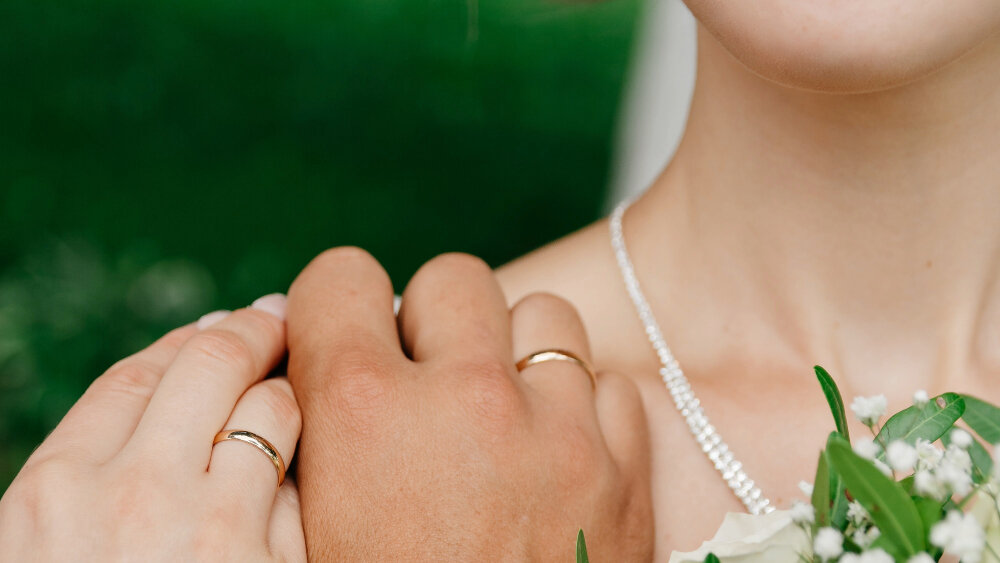
Gold, Platinum, Diamonds: A Cost Comparison
You have the choice between various metals, including gold and platinum. Starting with platinum, this can be a good option if you value the incredible sheen and strength of this precious metal. Platinum is a truly beautiful metal, and is widely regarded as one of the most desirable metals for wedding jewelry. In person, it is visibly ‘brighter’ than silver, and boasts a much whiter hue than white gold, which retains a slight echo of yellow. It is also naturally strong, meaning that it will stay looking as beautiful as the day you first put it on.
But, is it worth the extra cost? Definitely – if you can factor that cost into your budget. Don’t make the mistake of thinking that platinum is unrivalled, because it isn’t – a gold band will probably cost you less, and still look incredible (now, and into the future).
In actual fact, while gold is priced higher by ounce than platinum, more platinum is required to create a wedding band. How is this possible? Because platinum is so strong, wedding bands will feature a much higher level of purity – around 95-99%. Pure, 24k gold, on the other hand, is surprisingly soft; in other to be used in a wedding band, it needs to be less pure – typically 14k – 18k.
Rose gold is typically cheaper than a lot of other options because, in order to attain that pink blush, gold is alloyed with copper – a relatively inexpensive metal – and silver.
Alloying gold with copper also has another, highly desirable effect: it makes it incredibly strong. In actual fact, an 18k rose gold band will be stronger than a band cast from 18k yellow or white gold – and, since the color can’t fade, it’ll stay looking beautiful throughout your married life.
Choosing the Right Gold Karat
While 18 karats will ensure strength without disrupting the natural beauty and coloration of pure gold too much, 14 karat gold represents an excellent compromise for couples on a tighter budget.
There is definitely a certain amount of prestige attached to ‘pure’ gold, but once you get to your jeweler and see these two options side-by-side, we’re willing to bet you’ll find it hard to spot the difference – unless, of course, you’re the jeweler.
14 karat gold will be the tougher choice. It features a subtler yellow color, while 18 karat gold appears a little more luminescent.
18 karat gold is certainly better for those with allergies. At 75% purity, there are fewer alloys (such as nickel, zinc, or copper) to cause irritation.
Custom Design: A Price to Pay?
A custom design can have huge sentimental value at a relatively low cost. Adding additional features like engraving, heirloom side stones, or some other subtle design feature that means something to the two of you is a great way to show how well you know your significant other,
Still, there are plenty of beautiful designs out there, ranging from elegant and minimal to more ornate and luxurious. If you’re struggling to get your design to fit your budget, you can make minor tweaks like switching to a lower karat gold, or swapping that embedded diamond for a lower carat weight.
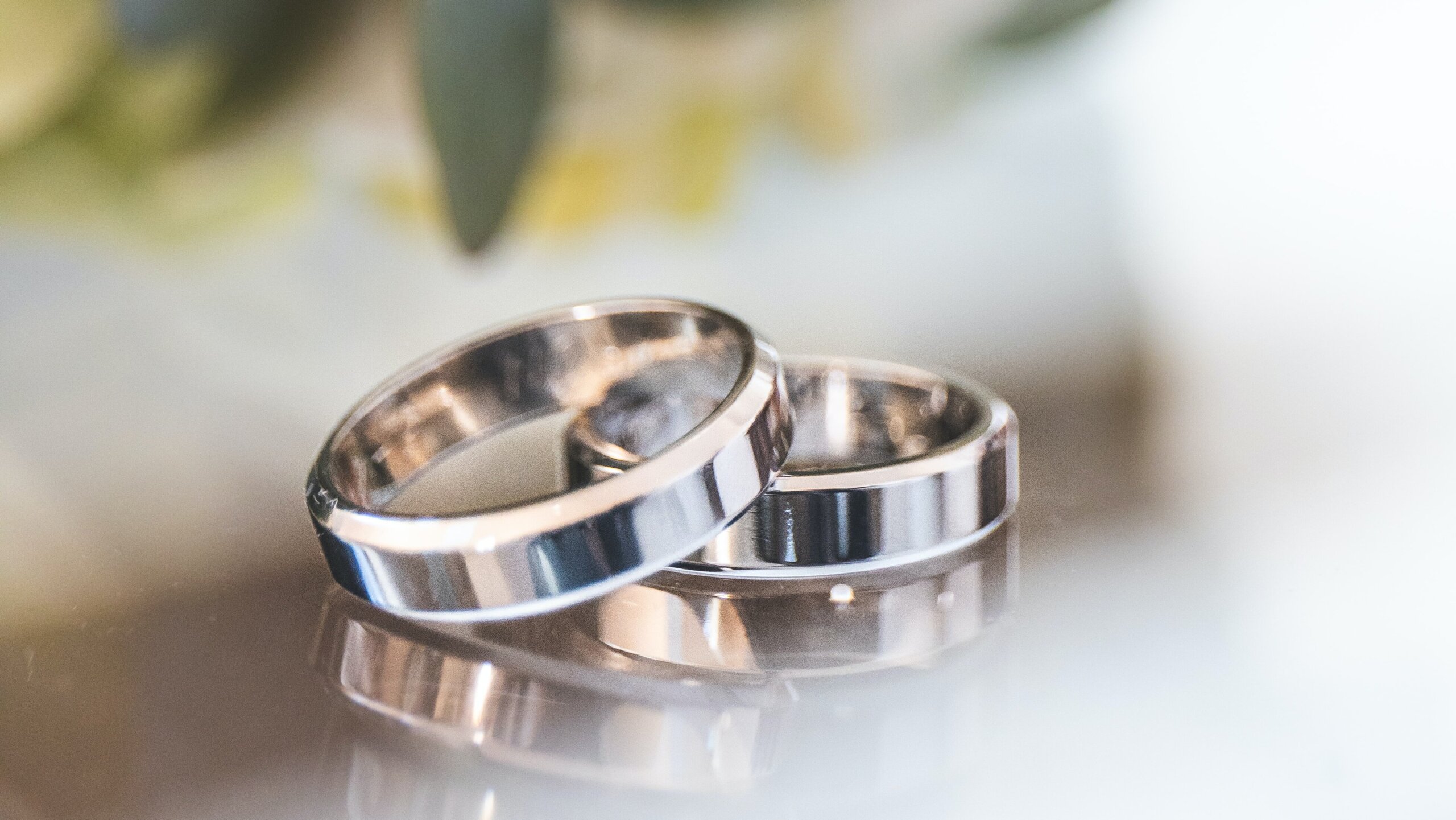
Engagement Ring vs. Wedding Ring
Lastly, it’s important to remember that the bride will pay for the groom’s wedding ring, and vice versa.
We don’t want to muscle in on the money talks – and how you manage the wedding budget depends entirely on each couple – but, while it falls on the man’s shoulders to pay for the engagement ring, the typical way of doing things has each partner pay for the other’s wedding ring.
This likely stems from the fact that the rings are given as a part of the ceremony and, while the couple may well choose them together, treating them like ‘gifts’ can make that moment even more special.
So, the bottom line is this: think about how much you can afford to spend on your wedding bands, and what aspects you’re willing to save on (if, of course, you need to save at all), and work with your jeweler to find the best option to meet your criteria.
Our Expert Take
The wedding ring is an important consideration, but you can relax a little. Not only is it (typically) a lot cheaper than the engagement ring, it’s also something you can choose together, rather than on your own. Still, don’t push it to the last minute – or the very last of your wedding budget. You’ll want to find something beautiful, wearable, and durable.
10 FAQs
- 1. What is the average cost of a wedding ring?
- The average cost can vary widely based on material, design, and region. Typically, simple gold wedding bands range from $300 to $1,000, while those with embellishments or diamonds can be significantly higher.
- 2. Is it more expensive to custom-design a wedding ring?
- Yes, custom designs generally cost more due to the unique craftsmanship involved. However, the price increase depends on the complexity of the design and the materials used.
- 3. Can the choice of metal significantly affect the wedding ring’s price?
- Absolutely. Gold, platinum, and palladium are typically more expensive than metals like titanium or stainless steel.
- 4. Are there ways to save on wedding ring costs without compromising quality?
- Yes, consider choosing lower karat gold, opting for smaller or fewer gemstones, and comparing prices from different retailers.
- 5. How much should I spend on a wedding ring?
- This is subjective and depends on personal budgets and preferences. A common approach is to spend what feels comfortable without straining your finances.
- 6. Does engraving a wedding ring increase its cost?
- Yes, engraving adds to the cost, but it’s usually a nominal fee compared to the ring’s total price.
- 7. Are online retailers cheaper for wedding rings than traditional stores?
- Often, yes. Online retailers typically have lower overhead costs, which can translate to lower prices for the consumer. However, it’s important to ensure that you’re purchasing from a reputable online jeweler.
- 8. Should I consider insurance for my wedding ring?
- Insurance is a good idea, especially for more expensive rings, as it protects against loss, theft, and sometimes even damage.
- 9. How do gemstones other than diamonds affect the price of a wedding ring?
- Using gemstones like sapphires, rubies, or moissanite can be a cost-effective alternative to diamonds while still offering beauty and durability.
- 10. Can the width and thickness of a wedding band affect its cost?
- Yes, wider and thicker bands use more material, which can increase the price. Opting for a slimmer band can be a way to reduce costs.
Discover your perfect ring at the right price with Jeweler AI. Elevate your ring selection journey today!
FOLLOW-UP GUIDE SERIES

